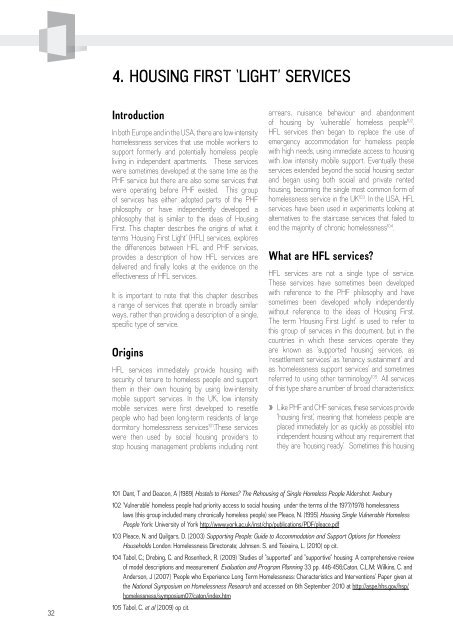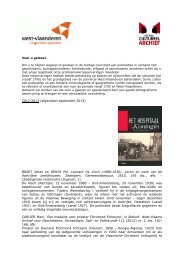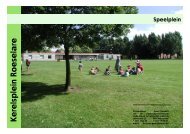Housing First - Provincie West-Vlaanderen
Housing First - Provincie West-Vlaanderen
Housing First - Provincie West-Vlaanderen
Create successful ePaper yourself
Turn your PDF publications into a flip-book with our unique Google optimized e-Paper software.
4. <strong>Housing</strong> <strong>First</strong> ‘Light’ ServicesIntroductionIn both Europe and in the USA, there are low-intensityhomelessness services that use mobile workers tosupport formerly and potentially homeless peopleliving in independent apartments. These serviceswere sometimes developed at the same time as thePHF service but there are also some services thatwere operating before PHF existed. This groupof services has either adopted parts of the PHFphilosophy or have independently developed aphilosophy that is similar to the ideas of <strong>Housing</strong><strong>First</strong>. This chapter describes the origins of what itterms ‘<strong>Housing</strong> <strong>First</strong> Light’ (HFL) services, exploresthe differences between HFL and PHF services,provides a description of how HFL services aredelivered and finally looks at the evidence on theeffectiveness of HFL services.It is important to note that this chapter describesa range of services that operate in broadly similarways, rather than providing a description of a single,specific type of service.OriginsHFL services immediately provide housing withsecurity of tenure to homeless people and supportthem in their own housing by using low-intensitymobile support services. In the UK, low intensitymobile services were first developed to resettlepeople who had been long-term residents of largedormitory homelessness services 101 .These serviceswere then used by social housing providers tostop housing management problems including rentarrears, nuisance behaviour and abandonmentof housing by ‘vulnerable’ homeless people 102 .HFL services then began to replace the use ofemergency accommodation for homeless peoplewith high needs, using immediate access to housingwith low intensity mobile support. Eventually theseservices extended beyond the social housing sectorand began using both social and private rentedhousing, becoming the single most common form ofhomelessness service in the UK 103 . In the USA, HFLservices have been used in experiments looking atalternatives to the staircase services that failed toend the majority of chronic homelessness 104 .What are HFL services?HFL services are not a single type of service.These services have sometimes been developedwith reference to the PHF philosophy and havesometimes been developed wholly independentlywithout reference to the ideas of <strong>Housing</strong> <strong>First</strong>.The term ‘<strong>Housing</strong> <strong>First</strong> Light’ is used to refer tothis group of services in this document, but in thecountries in which these services operate theyare known as ‘supported housing’ services, as‘resettlement services’ as ‘tenancy sustainment’ andas ‘homelessness support services’ and sometimesreferred to using other terminology 105 . All servicesof this type share a number of broad characteristics:❱❱Like PHF and CHF services, these services provide‘housing first’, meaning that homeless people areplaced immediately (or as quickly as possible) intoindependent housing without any requirement thatthey are ‘housing ready’. Sometimes this housing32101 Dant, T and Deacon, A (1989) Hostels to Homes? The Rehousing of Single Homeless People Aldershot: Avebury102 ‘Vulnerable’ homeless people had priority access to social housing under the terms of the 1977/1978 homelessnesslaws (this group included many chronically homeless people) see Pleace, N. (1995) <strong>Housing</strong> Single Vulnerable HomelessPeople York: University of York http://www.york.ac.uk/inst/chp/publications/PDF/pleace.pdf103 Pleace, N. and Quilgars, D. (2003) Supporting People: Guide to Accommodation and Support Options for HomelessHouseholds London: Homelessness Directorate; Johnsen. S. and Teixeira, L. (2010) op cit.104 Tabol, C.; Drebing, C. and Rosenheck, R. (2009) ‘Studies of “supported” and “supportive” housing: A comprehensive reviewof model descriptions and measurement’ Evaluation and Program Planning 33 pp. 446-456;Caton, C.L.M; Wilkins, C. andAnderson, J (2007) ‘People who Experience Long Term Homelessness: Characteristics and Interventions’ Paper given atthe National Symposium on Homelessness Research and accessed on 6th September 2010 at http://aspe.hhs.gov/hsp/homelessness/symposium07/caton/index.htm105 Tabol, C. et al (2009) op cit.
















